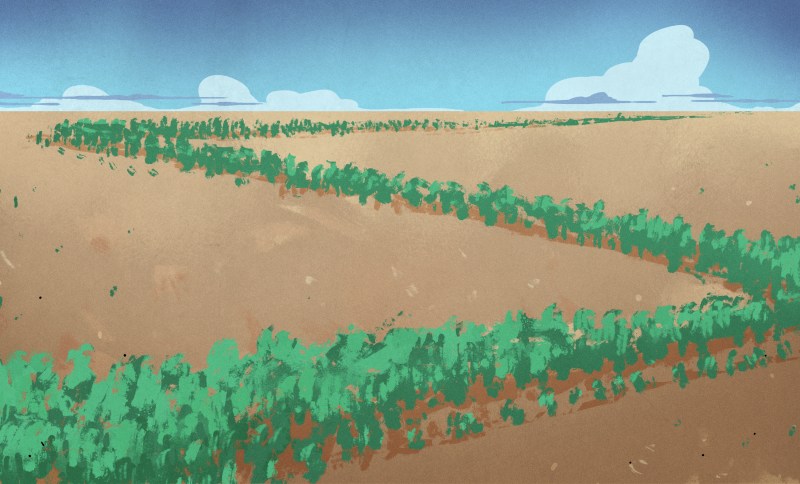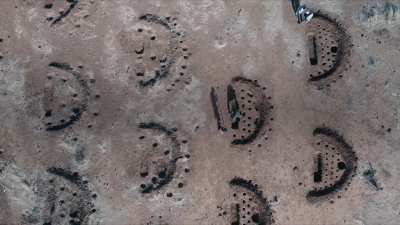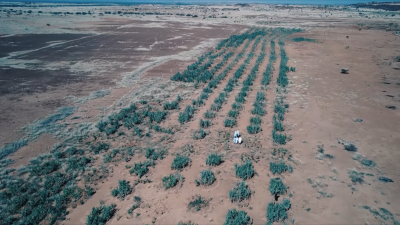As our climate changes, we fear that warmer temperatures and drier conditions could make life hard for us. In most locations, it’s a future concern that feels uncomfortably near, but for some locations, it’s already very real. Take the Sahara desert, for example, and the degraded landscapes to the south in the Sahel. These arid regions are so dry that they struggle to support life at all, and temperatures there are rising faster than almost anywhere else on the planet.
In the face of this escalating threat, one of the most visionary initiatives underway is the Great Green Wall of Africa. It’s a mega-sized project that aims to restore life to barren terrain.
A Living Wall

Launched in 2007 by the African Union, the Great Green Wall was originally an attempt to halt the desert in its tracks. The Sahara Desert has long been expanding, and the Sahel region has been losing the battle against desertification. The Green Wall hopes to put a stop to this, while also improving food security in the area.
The concept of the wall is simple. The idea is to take degraded land and restore it to life, creating a green band across the breadth of Africa which would resist the spread of desertification to the south. Intended to span the continent from Senegal in the west to Djibouti in the east, it was originally intended to be 15 kilometers wide and a full 7,775 kilometers long. The hope was to complete the wall by 2030.
The Great Green Wall concept moved past initial ideas around simply planting a literal wall of trees. It eventually morphed into a broader project to create a “mosaic” of green and productive landscapes that can support local communities in the region.
Reforestation is at the heart of the Great Green Wall. Millions of trees have been planted, with species chosen carefully to maximise success. Trees like Acacia, Baobab, and Moringa are commonly planted not only for their resilience in arid environments but also for their economic benefits. Acacia trees, for instance, produce gum arabic—a valuable ingredient in the food and pharmaceutical industries—while Moringa trees are celebrated for their nutritious leaves.
Choosing plants with economic value has a very important side effect that sustains the project. If random trees of little value were planted solely as an environmental measure, they probably wouldn’t last long. They could be harvested by the local community for firewood in short order, completely negating all the hard work done to plant them. Instead, by choosing species that have ongoing productive value, it gives the local community a reason to maintain and support the plants.
Special earthworks are also aiding in the fight to repair barren lands. In places like Mauritania, communities have been digging half-moon divots into the ground. Water can easily run off or flow away on hard, compacted dirt. However, the half-moon structures trap water in the divots, and the raised border forms a protective barrier. These divots can then be used to plant various species where they will be sustained by the captured water. Do this enough times over a barren landscape, and with a little rain, formerly dead land can be brought back to life. It’s a traditional technique that is both cheap and effective at turning brown lands green again.
Progress

The initiative plans to restore 100 million hectares of currently degraded land, while also sequestering 250 million tons of carbon to help fight against climate change. Progress has been sizable, but at the same time, limited. As of mid-2023, the project had restored approximately 18 million hectares of formerly degraded land. That’s a lot of land by any measure. And yet, it’s less than a fifth of the total that the project hoped to achieve. The project has been frustrated by funding issues, delays, and the degraded security situation in some of the areas involved. Put together, this all bodes poorly for the project’s chances of reaching its goal by 2030, given 17 years have passed and we draw ever closer to 2030.
While the project may not have met its loftiest goals, that’s not to say it has all been in vain. The Great Green Wall need not be seen as an all or nothing proposition. Those 18 million hectares that have been reclaimed are not nothing, and one imagines the communities in these areas are enjoying the boons of their newly improved land.
In the driest parts of the world, good land can be hard to come by. While the Great Green Wall may not span the African continent yet, it’s still having an effect. It’s showing communities that with the right techniques, it’s possible to bring some barren zones from the brink, turning hem back into useful productive land. That, at least, is a good legacy, and if the projects full goals can be realized? All the better.

















It’d be interesting to know the rate of reclamation over the last 17 years. I’d expect it to have probably been somewhat slow going at first, with later acceleration, especially as the results and benefits started to be seen. In which case, the next six years could get farther than you might expect. Probably still well short of the goal, but I’d hope they’d have some momentum and motivation to keep going past 2030.
Lord knows they’re going to need to.
Also, I wonder if this has inspired similar efforts elsewhere in arid regions.
Also also, might not be a bad idea to try some of this in the US. Get those half-moon divots dug before a drought even starts.
I like your point re: acceleration — as long as it manages to take hold, at some point it’ll hit kind of a hockey stick moment and really take off.
It’s so heartening to hear people applying their labour, time, money, intelligence, etc to projects that restore the earth. This is the kind of hack I want to read more about.
FDR folly – Great Plains Shelterbelt…
Explain “folly”. It did what it was intended to do, and still exists to this day.
What was fate of most of cottonwood seedlings after few years?
I don’t know the fate of “most”, but there were quite a few mature trees around in the 1980s.
You should plant a Cottonwood near your house Ren.
The roots do great things for foundations. Double plus good!
From the Oklahoma Historical Society:
“Shelterbelts varied in length and ranged from 100 to 165 feet wide. Rows were planted ten feet apart, with tall trees in the center rows, flanked by rows of short trees along the sides, and shrubs in the outside rows. Black locust, catalpa, Chinese elm, cottonwood, green ash, hackberry, honey locust, mulberry, Osage orange, pecan, plum, Russian olive, red cedar, and walnut were commonly planted.”
They didn’t only plant cottonwood. Many of the belts are still extant, albeit needing some maintenance work.
122L14 – If that Shelterbelt was “folly”, what word would you use for the practices that necessitated FDR’s response?
If you don’t want medicine, don’t cause sickness. It’s rather plain that most of the folks against government intervention, simply shrug at industrial scale disasters that necessitated a response.
no need for government intervention, private companies or nonprofits can do the job
> no need for government intervention, private companies or nonprofits can do the job
Haha, good one. Unless you’re serious, in which case let me laugh even harder.
If it were profitable, private companies would already be doing it. And no, greenwashing Chevron’s emissions with token tree-planting doesn’t count.
Nick. Shelterbelts did f-all but drain money. It’s history.
Farmers learned to plant rows of trees on fence lines. That’s what changed.
Nick:
“If it were profitable, private companies would already be doing it. And no, greenwashing Chevron’s emissions with token tree-planting doesn’t count.’
Boise Cascade, Georgia Pacific, Starker Lumber . . . All the timber companies plant trees, as do small woodlands owners because trees are a crop, and healthy forests are where they grow best.
Massive government programs are wasteful, corrupt and generally fail to do anything that they claim to be aiming for. Take a look at the beetle-kill and wildfire wracked national forests and wilderness areas in the West. Spot logging is not allowed to maintain them so they die, burn, and go senescent — all of which is carbon-positive in emissions if you care about that.
when logging is allowed, you can bet it is to benefit a lobbyist, not the loggers.
Loving wildlife is best in a healthy forest. Logging, that is modern logging and not the despoilation of the 1880s, keeps forests healthy, productive, and gives kids in the surviving mill towns a future to look forward to, besides doing meth or moving to LA where the benefits are larger.
From what I read countries where efforts have been made are not interested in funding this _at all_.
An article that reminds me of Chrono Trigger is by default a good article.
Fiona’s Forest!
Chicom version caused significant drop of water table, african ones(it isn’ single program) are plagued with this and other problems(like public land grab in Nigeria or controling community of shepards in Algeria and so on…).
Did the Chinese use appropriate plant species for the local conditions, or something that was aesthetically/ideologically/politically chosen?
Also the water retention measures might help prevent that, if the Chinese efforts lacked them.
Meanwhile in parts of Australia, the problem is that the water table is TOO high, bringing excess salts with the water. Planting deep-rooted trees helps put the water table back at a safe depth.
Sustainability is hard. Pointing to a single failure in a foreign country, without any context, is meaningless at best, and potentially misleading.
https://en.wikipedia.org/wiki/Dryland_salinity
Could always try to cloud seed from the ocean, try to direct a tropical storm in the middle of the Sahara and see what happens
Get a foot of rain in a year see what it do…
Like nevada and death valley
Even standing water in a desert is better than no water
Problem is, how you refertilize sand and silt and maybe salt.
Could just throw biodegradable food waste and septic tank systems… Still need topsoil and aggregate to hold nutrients and moisture and keep sand from blowing up dust
Smell like shit, but food crop grow big and scrong sipping on dookie water if the proper septic and distribution system is used
And compost food waste with the needed topsoil mixture, along with things like peat moss and sawdust or wood chips
Yeah buying dirt is a real industry and business
Google says the Sahel has a population density of 31/km^2.
That’s 80/mile^2 in non-frogish (frogcois?) stubby dictator units.
Those ‘shithole countries’ lack sufficient shitholes to supply fertilizer.
We should ship them the entirety of DC. The USA’s shithole.
The EU could ship them the entirety of Brussels.
Everybody would be happier.
I agree with HaHa on shipping over DC, that also removes a large source of CO2 that produces no valuable work.
One of the most common ways to die in the Sahara is by drowning due to flash flooding. One of the problems of a landscape made of stones is that water doesn’t hang around.
Citation?
I doubt that, even if you stretched ‘most common’ to top 10.
Just on the infrequency of flash flooding in the Sahara vs war, car accidents, thirst, starvation, heart attack, African maintenance, cancer, ‘hold my bear and watch this’, stupidity etc etc.
BTW this is about the sahel. South of the Sahara.
Who dies in the “hold my bear” scenario?
Would work even better with these divots to catch and retain water rather than letting it flow away.
20 percent of the soil in the Amazon Rainforest (and nutrients) comes from Sahara duststorms.
Therefore, the Sahara is not all rocks and sand.
The government level approach may have slowed but local communities have continued and expanded the concept. The grass roots results are impressive.
https://www.smithsonianmag.com/science-nature/great-green-wall-stop-desertification-not-so-much-180960171/
This makes me think of groasis waterboxx. They are in the reforestation business and are located in the Netherlands.
The best historic case of reforestation is the eastern half of the USA.
Was deforested 100+ years ago.
But now is reforested, thanks to suburbs and big yards. Yeah cars! Boo trains!
Air coming off the east coast has less CO2 then air blowing onto the west coast.
Need to make Amazon rainforest a big suburb! Filled with prosperous people driving V8s.
In the eastern U.S. forests grow nearly every place they’re not actively discouraged. Farmland needs to be maintained by regularly cutting back trees, or it won’t long be farmland.
The world’s big deserts need special efforts to sustain trees or food crops.
“But now is reforested, thanks to suburbs and big yards.”
Mostly thanks to oil and gas heat, and the decline of wooden shipbuilding.
People planted those trees because they liked trees, owned land and had room.
Yeah room!
Yeah land ownership!
Boo dense urban living!
Boo Brutalist architecture!
Boo HOAs!
Yeah private 400 yard shooting ranges!
Yeah Tequila!
Yeah Tannerite!
Yeah Torque!
Creosote treatment of railroad ties reduced the number of trees used for ties by 75%. The switch from horses to tractors eliminated the need for 25% of the farm’s land to be set aside to feed the horses.
Sadly, my suburb is infested with those obsessed by treeless lawns, cut by mowing every couple days whether it needs it or not.
When you pay people to plant trees they will cut down mature trees to make room for new ones.
You get what you incentivize, same as always.
While there’s plenty of land without trees on already that’s not going to be a problem. Cutting down trees is still work.
How much water will the trees get once out of the cash cow window?
This has all happened before, they predictably start by planting trees.
Outside the sahel, once it becomes a walk to find bare ground? They still need firewood.
Short water environment? The outcome is predictable.
Better incentivize bigger trees, not trees planted.
Water is gold there, but that doesn’t really matter.
It’s the same wherever this kind of thing is tried.
Do gooders are a valuable resource to be exploited.
What trees in the Sahara? And the landscaping is as important as the tree planting.
How much of this is bankrolled by foreign aid and how much of it will be abandoned and in ruins in ten years like all the other efforts to improve Africa since the 1960s
It’s Africa.
80% of the money goes to swiss bank accounts of their ‘leadership’.
Nothing changes.
China is learning this, same as the Brits did.
It’s easy to loan African nations money, impossible to collect.
Revolution! We don’t owe you anything. Collect from the corpses.
The difference is that China could not care less about “saving the world” or improving the lives of people in Africa. They are investing in access, influence, and control. And it works.
Nobody is interested in ‘improving lives’.
Suspect anybody who claims they are, just bold faced liars.
Kick them square in the crotch and walk away.
The only people worse then money grubbers are power grubbers.
The English also got ‘access, influence and control’. Until they got the boot. Africa is still using the English rail lines, as they will the Chinese ones.
Africa is an Illuminati game. ‘Future deals’ are unenforceable.
The thing is, we need those aid projects in order to help Toyota maintain Land Cruiser J70 production lines operational.
Look at what happened to Tarpan Honker – a brilliant car which could become Poland’s own platform for an EV SUV or a 4×4 roadster (like Miata, but easier to repair and suitable for crumbling polish roads). Due to lack of government support it never became a mass-market car and now it’s gone forever. The only way to buy one is to look at military surplus – which after 2022 became “gl & hf” situation.
Is this a message from parallel mirror universe? “article about Environment so Im gonna bring 4x4s into this” ??!?!?!
and this Honker https://youtu.be/vbKR3suRzKI?feature=shared&t=82 ? :] The absolutely worst 4×4 on the planet? Yes, even worse than Aro!
Actually… imagine Tarpan Honker chassis, drivetrain and 4CT90 engine combined with Aro M461 bodywork.
A perfect Mazda MX-5 subsitute for young people living in a troubled socialist economy. Two seats, mid-engined RWD/AWD car with removable soft top.
Just think about it… perhaps you want take your gf to watch sunset at the beach. Now you can! Even better – without wasting time having to look for car park, then paying for parking tickets and walking rest of the way through forest. Just take a dirt road and drive directly to the seaside. Likely you won’t even have to leave your car when doing “have a romantic moment” task. When you’re done, you can ride back straight to the hotel. This way you’re always accomplishing 120% of norm (efficiency); even if the task at hand is having a week of rest from factory work.
Lose the bodywork. Put on quite exhaust. Blend in.
Replace shell w limping wrecked rusty Lada bits and plywood (or other POS typical to area).
The bad car, that nobody wants, even for free.
A New Bug in the USA. Convertible.
G.D. California Air Board. Fun is outlawed.
You need a pre 1975 title and ‘car’…state ref anyhow…no fun at all.
Gonna want to see some sort of part from the ‘car’, somewhere.
15 by 7700 klicks is 110000+ square klicks. At a 100 hectares per, that’s 11 million hectares, not 110 million. Which is apparently what’s been done. Where did I goof?
110000 is 1.1×10^5 square clicks. That x 100 is 1.1×10^8 hectares, which is 110×10^6 or 110 million.
I recall back in the late 1980’s studies that claimed the expanding desert was caused by the US and the Peace Corp. A huge number of US college students had joined the Peace Corp near the end of the Vietnam War to avoid the draft lottery. Many of the were sent to Africa and a major task was digging/drilling water wells for stock tanks throughout sub-Sahara. Aerial photos over time showed the water tanks losing immediate vegetation because the animals tended to stay near. The bare circles expanded over time and eventually overlapped. Combined with water table drop, the vastly accelerated the southern of the desert.
I don’t know if this was proven to be the cause and it might be hard to find out. We know how hard bureaucracies and academics will work to avoid being shown to be wrong. Or how much many would love to absorb this into apocalyptic climate and grant money. Anyway, it makes a good story and some sense. If true, is it reversible?
“I don’t know if this was proven to be the cause”
I would wager there are many things you don’t know.
Even the wisest person in the world does not know many more things than he knows.
18 million hectares is 180 000 square kilometers. That is a square with one side more than 400 km. If true, this is amazing.
I didn’t see any racist comments here and there is no objective definition for “bigotry”. What is objectively true is that you are name calling two users on this platform. I hope the mods remove your comment. Your comment is completely off topic.
I’ve been following the “just diggit” project for years. The results speak for themselves. It changes local climates and local economies. Improving nature and quality of life for people. I call that a success.
At the same time, China did a huge reforestation effort (search for great green wall of china) that should recover the Gobi desert in the next 300 years (it goes from growing 10’000 sq km per year in 1980 to shrinking by 2’000 sq km per year in 2022).
Ignore the vids of Chinese people spray painting sand green or planting ‘crete on rebar flowers.
Those are all Indian/Taiwanese/American/Japanese propaganda!
Also drink the Chinese beer made with Shanghai city water! (Anglicised to SingHa. Same as the Thai beer, tricky bastards.)
It won’t give you cancer, at all. Taste is comparable to American brands like Wiedemann’s, Carlings Black Label and Coors. Filtered through the finest mangey dog tails available.
If it’s one thing mainland China is known for, it’s wholesome, high quality food and drink.
One job is to keep sheep and goat away from eating young plants to the roots.
Otherwise nature does a good job replanting itself. First plants will grow that can live on poor soil. They will improve soil quality and richer plants will appear. Don’t waiste too much effort and money on what nature will do better.
Why isn’t Texas behind this with a vengeance? After all every year we get terrible sand clouds from the Sahara dust storms and they cause all kinds of health problems. Yes the sand get picked up into the air at the Sahara and the trade winds bring it right over to the gulf of Mexico and up into Texas.
For Texas it would save tons of money on health care.